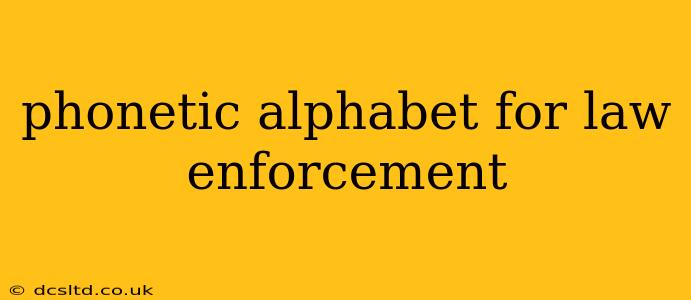Law enforcement communication demands precision and clarity, especially during high-stakes situations. Ambiguity can have life-or-death consequences. That's why a standardized phonetic alphabet is crucial – it eliminates misunderstandings caused by similar-sounding words or regional accents. This article will explore the phonetic alphabet commonly used by law enforcement, its importance, and answer frequently asked questions.
Why is a Phonetic Alphabet Important for Law Enforcement?
Misunderstandings during emergencies can be catastrophic. A simple mishearing of a location, suspect description, or vehicle detail can lead to wasted time, compromised safety, and even tragic outcomes. The phonetic alphabet mitigates these risks by providing a consistent, unambiguous way to transmit critical information, regardless of background noise or communication challenges. It ensures everyone involved is on the same page, fostering efficient and coordinated responses.
What Phonetic Alphabet Do Law Enforcement Agencies Use?
The most widely adopted phonetic alphabet within law enforcement and other public safety agencies is the NATO phonetic alphabet. This system assigns a unique, easily distinguishable word to each letter of the alphabet. This helps prevent confusion between letters like "B" and "D," or "M" and "N," which can sound very similar when spoken quickly or over a noisy radio channel.
Here's the NATO phonetic alphabet:
- A - Alpha
- B - Bravo
- C - Charlie
- D - Delta
- E - Echo
- F - Foxtrot
- G - Golf
- H - Hotel
- I - India
- J - Juliet
- K - Kilo
- L - Lima
- M - Mike
- N - November
- O - Oscar
- P - Papa
- Q - Quebec
- R - Romeo
- S - Sierra
- T - Tango
- U - Uniform
- V - Victor
- W - Whiskey
- X - X-ray
- Y - Yankee
- Z - Zulu
How is the Phonetic Alphabet Used in Law Enforcement?
The phonetic alphabet isn't just for spelling out license plates or names. It's used across various communication scenarios, including:
- Vehicle descriptions: "Suspect vehicle is a blue Ford, Uniform-Oscar-Lima-Foxtrot." (UOLF)
- Location details: "Incident reported at Alpha-Bravo-Charlie Street and Delta Avenue." (ABC & D)
- Suspect identification: "Suspect is described as a male, six foot tall, wearing a red shirt, Romeo-Oscar-Mike-Echo-Oscar." (ROMEO)
The use of the phonetic alphabet ensures that all officers, dispatchers, and other emergency personnel understand the information correctly, regardless of background noise or individual accents.
What are Other Common Phonetic Alphabets Used?
While the NATO phonetic alphabet is the most prevalent, other variations exist. Some agencies may use slightly different words for certain letters, but the core principle remains the same: unambiguous communication through distinct phonetic identifiers. Consistency within a specific agency or jurisdiction is key to effective communication.
Are there any other important communication protocols used in law enforcement?
Beyond the phonetic alphabet, effective law enforcement communication relies heavily on clear and concise language, standardized codes, and procedures to ensure rapid and accurate information exchange. These protocols are tailored to specific situations and agency requirements, further reducing the chances of errors and promoting better coordination during emergencies.
What are the benefits of using the phonetic alphabet in law enforcement?
The benefits are numerous and crucial for safety and efficiency:
- Clarity: Reduces ambiguity and misunderstandings.
- Accuracy: Ensures accurate transmission of information.
- Efficiency: Improves speed and coordination of responses.
- Safety: Minimizes errors that could lead to dangerous situations.
- Standardization: Provides a common language for all personnel.
In conclusion, the phonetic alphabet is a critical tool for law enforcement, enhancing communication clarity, ensuring accuracy, and ultimately contributing to safer and more effective operations. Its consistent usage is a cornerstone of successful emergency response and proactive policing.
